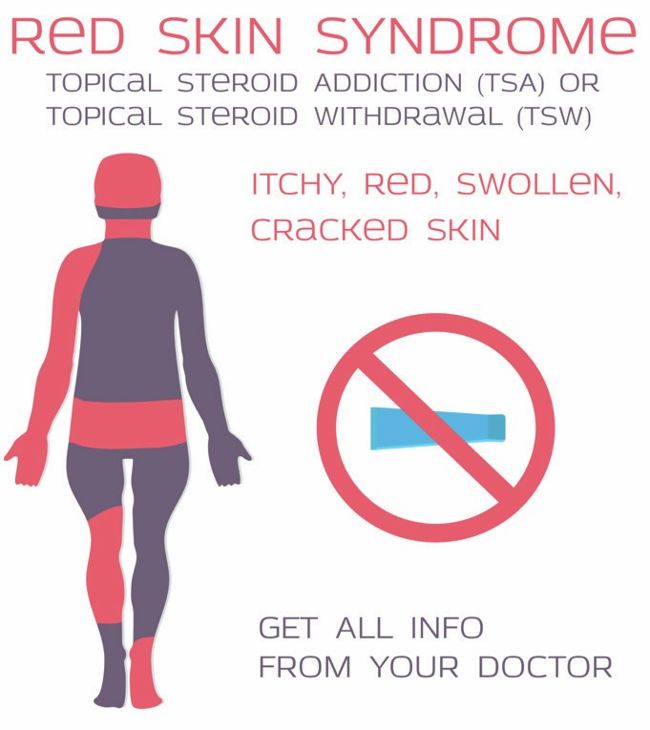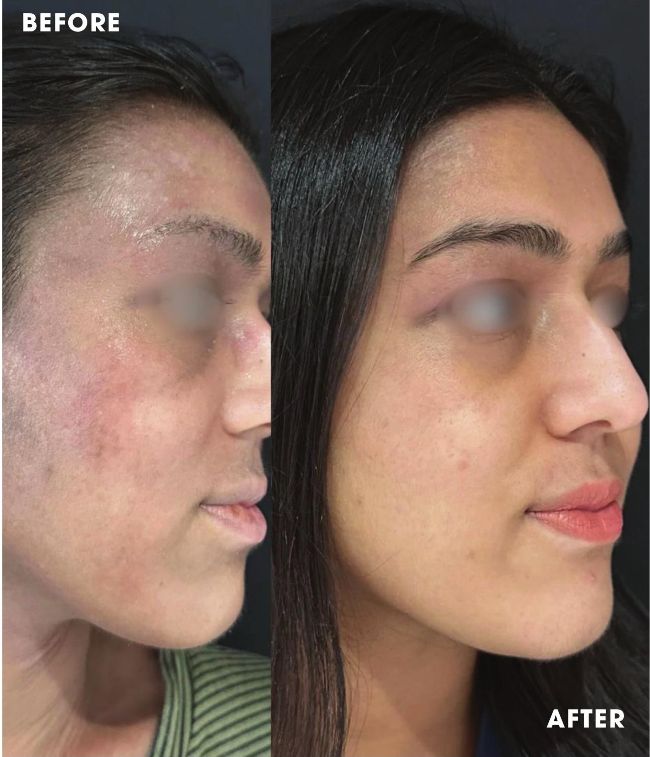CLINICAL
Topical steroid withdrawal
Jennifer Thain talks through how she treated a patient with eczema using a combination light therapy approach
Topical steroid withdrawal (TSW) is an increasingly recognised condition characterised by severe cutaneous flares following the cessation of prolonged corticosteroid use. This case study explores the presentation and successful management of a female patient with chronic eczema and TSW using Dermalux light therapy in conjunction with the twice-daily application of Cellderma GF5 serum.
THE PATIENT
A female patient, aged 28, presented with extensive eczematous dermatitis and a history of long-term topical corticosteroid use. Her condition was complicated by TSW, characterised by skin barrier dysfunction and persistent weeping lesions. She reported a recurrent cycle of corticosteroid prescription, withdrawal-induced flares, and subsequent re-prescription of increasingly potent formulations.
The patient initially developed dermatitis symptoms during the Covid-19 pandemic, attributing the onset to prolonged mask use. Due to limited access to in-person consultations, she was prescribed 1% topical corticosteroids remotely, followed by progressively stronger formulations as tolerance developed. Despite medical recommendations advocating for a gradual tapering approach to corticosteroid discontinuation, her prescribing physician instructed her to immediately cease usage, leading to severe withdrawal symptoms. Gradual tapering of topical corticosteroids is recommended to minimise the risk of withdrawal symptoms and adverse effects. This approach involves reducing the potency and frequency of application over time, rather than abrupt discontinuation. For example, after two to four weeks of daily use, it’s advisable to decrease the application frequency to twice weekly and opt for a lower-potency steroid.
This prescription-withdrawal-prescription cycle persisted over 24 months, significantly impairing her quality of life. Given the extended waiting times for NHS dermatology services in her locality (approximately four years), the patient sought alternative treatments. Following unsuccessful acupuncture treatment, a referral was made by her acupuncturist to the clinic, where a comprehensive dermatological assessment was conducted.
THE CONSULTATION
During the consultation, we discussed various options. The first option was to do nothing, as the client was very nervous about introducing new treatments or products due to her experience, and her very sensitive and at times painful skin. I also recommended medical-grade skincare, which the patient did not want to use initially due to her skin barrier being very compromised.
The patient agreed to my recommendation of using the Dermalux Tri-Wave LED light therapy for an initial period of once a week for 12 weeks. I did recommend twice weekly, but due to her work commitments, she was only able to attend clinic once a week for the treatment, hence the longer period of 12 weeks.
I recommended the Dermalux Tri-Wave because it is the only medical-grade LED light available worldwide, backed by science, for its ability to reduce inflammation at a cellular level. The Dermalux Tri-Wave MD is a medically certified LED phototherapy device that utilises three specific wavelengths – blue (415nm), red (633nm), and near-infrared (830nm) – to address various skin conditions. This device is designed to deliver these wavelengths individually or simultaneously, allowing for tailored treatments targeting multiple concerns. The patient also had an appointment with a consultant dermatologist who agreed with my recommendation of light therapy.
THE TREATMENT
I started the treatment with blue light to focus on the bacterial infection, then red light to address inflammation and infrared to boost collagen production. After 12 weeks of light therapy, we introduced Cellderma GF5 serum twice daily to support collagen production. I recommended the product because it has been created by a UK dermatologist who is accessible should practitioners have questions about its usage. It has also proven favourable for wound healing responses, which is what the patient was suffering from; weeping skin wounds due to the severity of her condition. Cellderma GF5 Next Generation is a bio-regenerative growth factor serum formulated to address various signs of skin ageing. This serum contains five bio-identical growth factors that promote skin repair and regeneration by stimulating collagen and elastin production, thereby enhancing skin firmness and elasticity.

In addition to growth factors, the serum includes neuropeptides that help minimise and prevent the formation of fine lines and wrinkles. The inclusion of copper tripeptide-1in the formulation is notable for its collagen-boosting and anti-inflammatory properties, contributing to overall skin health.2,3
A study by Naughton et al. (2023) evaluated the efficacy of a novel growth factor-based skin care serum (referred to as A+) in targeting multiple hallmarks of skin ageing through both preclinical and clinical assessments. Treatment with A+ reduced the expression of the senescence biomarker H2A.J in human skin explants, indicating a potential decrease in cellular ageing.
The serum increased the expression of genes linked to stemness and improved intercellular communication pathways, which are vital for skin regeneration. A 24-week, vehicle placebo-controlled clinical study involving subjects with moderate to severe facial photodamage demonstrated that A+ provided significant improvements compared to placebo in several parameters. Notable reductions in sagging, coarse and fine lines/wrinkles, overall photodamage, and hyperpigmentation were observed. Skin biopsies revealed decreased levels of H2A.J and increased expression of key dermal extracellular matrix components, including collagen and elastin, indicating structural skin improvements.4
After the patient grew in confidence, both with me as a practitioner and with the treatment, she allowed me to introduce medical-grade skincare. She now uses ZO Balancing Cleansing Emulsion, Cellderma Youth Restore – which isn’t as concentrated as GF5 – and of course, SPF. The patient comes into the clinic every few weeks as her schedule allows her to continue with light therapy to ensure she stays on top of her skin management. Of course, the patient has also successfully weaned off corticosteroids.
THE RESULTS
Both photos A and B (see over page) show the before photo of the patient on the left and the after photo of the patient on the right. The before and after photos were taken one year apart and show the significant improvement in the patient’s skin. The baseline images reveal a significantly compromised epidermal barrier, particularly in the eyebrow region, indicative of inflammatory and barrier dysfunction. The extent of epidermal damage resulted in eyebrow hair loss, a common manifestation in severe dermatological conditions such as atopic dermatitis or steroid withdrawal syndrome.
The post-treatment images demonstrate a marked improvement in skin integrity, with notable restoration of epidermal homeostasis. The patient exhibits a more uniform skin tone, reduced inflammation, and reestablishment of the skin’s protective barrier. Furthermore, full eyebrow regrowth is observed, indicating follicular recovery and normalisation of the hair growth cycle, suggesting successful resolution of underlying inflammation.

The patient has identified eyebrow regrowth as a significant milestone in her recovery, signifying not only dermatological improvement but also an enhancement in psychological wellbeing. This case underscores the importance of a comprehensive treatment approach in managing inflammatory skin conditions, focusing on barrier restoration, hair follicle viability, and overall skin health. A notable case report that aligns with my patient’s experience documented a mother and her 10-year-old son who both developed TSW after discontinuing high-potency topical corticosteroids used extensively over several years. Both patients experienced symptoms such as erythema, severe burning or stinging sensations, swelling, desquamation, and hair loss, including madarosis (loss of eyebrows). Management involved complete cessation of topical corticosteroids and supportive care, with significant improvement observed over two years.
CONCLUSION
This case highlights the complexities of managing TSW and the importance of a multidisciplinary, evidence-based approach to skin recovery. The patient’s experience underscores the significant impact of prolonged topical corticosteroid use and the challenges associated with abrupt cessation, leading to severe withdrawal symptoms and compromised skin integrity. The introduction of Dermalux Tri-Wave LED light therapy played a pivotal role in reducing inflammation, promoting epidermal healing, and supporting barrier restoration. The subsequent incorporation of Cellderma GF5 serum further enhanced skin regeneration through its growth factor-rich formulation, aiding in collagen production and overall tissue repair. The patient’s gradual acceptance of medical-grade skincare demonstrates the necessity of a patient-centric approach, ensuring that interventions align with individual comfort levels and skin tolerance.
The remarkable improvement in skin condition, including the regrowth of previously lost eyebrow hair, highlights the effectiveness of a structured and scientifically supported treatment regimen.
This case reinforces the need for greater awareness of TSW and the potential adverse effects of long-term corticosteroid use, advocating for alternative therapeutic options that prioritise skin barrier health. Ongoing management and follow-up will ensure sustained improvement, further emphasising the critical role of non-steroidal interventions in dermatological care.
JENNIFER THAIN
Jennifer Thain trained as a nurse at the University of Manchester 2011-14, and became NMC registered in November 2014. She completed her V300 NMP at Manchester Metropolitan University. She has also completed Clinical Diagnostics, Adult Clinical Examination and Paediatric Clinical Examination at Liverpool John Moore’s University in 2020.
Thain became a pediatric nurse at Alder Hey Hospital, before becoming a nurse prescriber in 2021. She’s the NW/Yorkshire regional lead for The Nurses Network.
She introduced skin subscriptions into clinic, which generates continual income and is a convenient solution for patients. Jennifer is currently studying level 7 aesthetics via the only nurse-led academy that is JCCP-approved.
She also has a diploma in dermatology – achieved via iHeed distance learning in Belfast so she could continue to practice – and plans to complete a master’s in dermatology. She is a member of the JCCP, BAMAN and continues to be a member of RCN.
REFERENCE
1. Topical corticosteroid withdrawal. DermNet. Available at: https://dermnetnz.org/topics/topical-corticosteroid-withdrawal
2. https://dermaluxled.com.au/tri-wave-md
3. https://cellderma.com/product/gf5/
4. Naughton GK, Jiang LI, Makino ET, Chung R, Nguyen A, Cheng T, Kadoya K, Mehta RC. Targeting Multiple Hallmarks of Skin Aging: Preclinical and Clinical Efficacy of a Novel Growth Factor-Based Skin Care Serum. Dermatol Ther (Heidelb). 2023 Jan;13(1):169-186. doi: 10.1007/s13555-022-008392. Epub 2022 Nov 14. PMID: 36374431; PMCID: PMC9823186.
5. Feschuk AM, Pratt ME. Topical steroid withdrawal syndrome in a mother and son: A case report. SAGE Open Med Case Rep. 2023 Apr 4;11:2050313X231164268. doi: 10.1177/2050313X231164268. PMID: 37051261; PMCID: PMC10084575.w